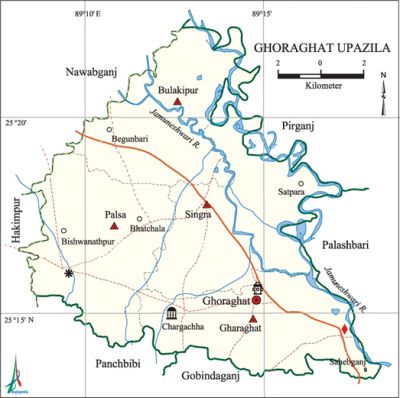Ghoraghat Upazila
Ghoraghat Upazila (dinajpur district) area 148.67 sq km, located in between 25°13' and 25°22' north latitudes and in between 89°08' and 89°18' east longitudes. It is bounded by nawabganj and pirganj (rangpur) upazilas on the north, panchbibi and gobindaganj upazilas on the south, palashbari and Pirganj upazilas on the east, hakimpur and Nawabganj upazilas on the west.
Population Total 103119; male 52554, female 50565; Muslim 88370, Hindu 6259, Buddhist 5292, Christian 125 and others 3073. Indigenous communities such as santal, oraon, Munda belong to this upazila.
Water bodies Main river: Jamunnesari.
Administration Ghoraghat Thana was formed in 1895 and it was turned into an upazila in 1984.
| Upazila | ||||||||
| Municipality | Union | Mouza | Village | Population | Density (per sq km) | Literacy rate (%) | ||
| Urban | Rural | Urban | Rural | |||||
|
- |
4 |
115 |
112 |
4554 |
98565 |
694 |
46.3 |
39.1 |
| Upazila Town | ||||||||
|
Area (sq km) |
Mouza |
Population |
Density (per sq km) |
Literacy rate (%) | ||||
|
5.07 |
3 |
4554 |
898 |
46.3 | ||||
| Union | ||||
| Name of union and GO code | Area (acre) | Population | Literacy rate (%) | |
| Male | Female | |||
|
Ghoraghat 38 |
8607 |
14984 |
14317 |
42.38 |
|
Palsa 57 |
9814 |
11599 |
11329 |
43.51 |
|
Bulakipur 19 |
9272 |
11859 |
11339 |
34.69 |
|
Singra 76 |
9045 |
14112 |
13580 |
37.01 |
Source Bangladesh Population Census 2001, Bangladesh Bureau of Statistics.

Archaeological heritage and relics Mosque at village Chargachha (Mughal period), tombs of Shah Ismail Ghazi and Badre Arefin.
Literacy rate and educational institutions Average literacy 26.1%; male 32.8%, female 19.2%. Educational institutions: college 8, secondary school 18, primary school 53, brac school 29, kindergarten 2, madrasa 34. Noted educational institutions: Ghoraghat Degree College (1984), Ghoraghat Women College (1994), Raniganj Mahila College (1994), Dugdugirhat Technical College (2003), Raniganj Bilateral High School (1945), Chatsal Secondary School (1946), Balahar Secondary School (1958), Balagari' Secondary School (1966), Gopalpur Secondary School (1972), Krishnarampur Fazil Madrasa (1946), Deogaon Rahmania Senior Madrasa (1947).
Cultural organisations Library 3, club 10, cinema hall 5.
Main sources of income Agriculture 68.64%, non-agricultural labourer 2.84%, industry 0.50%, commerce 12.95%, transport and communication 2.91%, service 4.35%, construction 0.53%, religious service 0.13%, rent and remittance 0.07% and others 7.08%.
Ownership of agricultural land Landowner 51.03%, landless 48.97%; agricultural landowner: urban 39.29% and rural 51.57%.'
Main crops Paddy, wheat, jute, corn, potato, mustard, vegetables.
Extinct or nearly extinct crops Sugarcane.
Main fruits Mango, watermelon, jackfruit, banana.
Communication facilities Pucca road 54.60 km, semi-pucca road 10.20 km, mud road 209.20 km.
Extinct or nearly extinct traditional transport Palanquin, horse carriage, bullock cart.
Cottage industries Goldsmith, blacksmith, potteries, wood work.
Hats, bazars and fairs Hats and bazars are 17, fairs 2, most noted of which are Raniganj, Osmanpur and Ghoraghat hats; Rishighat Mela and Gopalpur Mela.
Main exports Paddy, banana, watermelon.
Access to electricity All the unions of the upazila are under rural electrification net-work. However 22.52% of the dwelling households have access to electricity.
Sources of drinking water Tube-well 89.84%, tap 0.25%, pond 0.33% and others 9.58%.
Sanitation 27.58% (rural 26.40% and urban 53.35%) of dwelling households of the upazila use sanitary latrines and 24.16% (rural 24.41% and urban 18.53%) of dwelling households use non-sanitary latrines; 48.26% of households do not have latrine facilities.
Health centres Upazila health complex 1, union and family planning centre 4, satellite clinic 3.
NGO activities brac, asa, HEED Bangladesh, thengamara mahila sabuj sangha. [Shamsuzzaman]
References Bangladesh Population Census 2001, Bangladesh Bureau of Statistics; Cultural survey report of Ghoraghat Upazila 2007.
